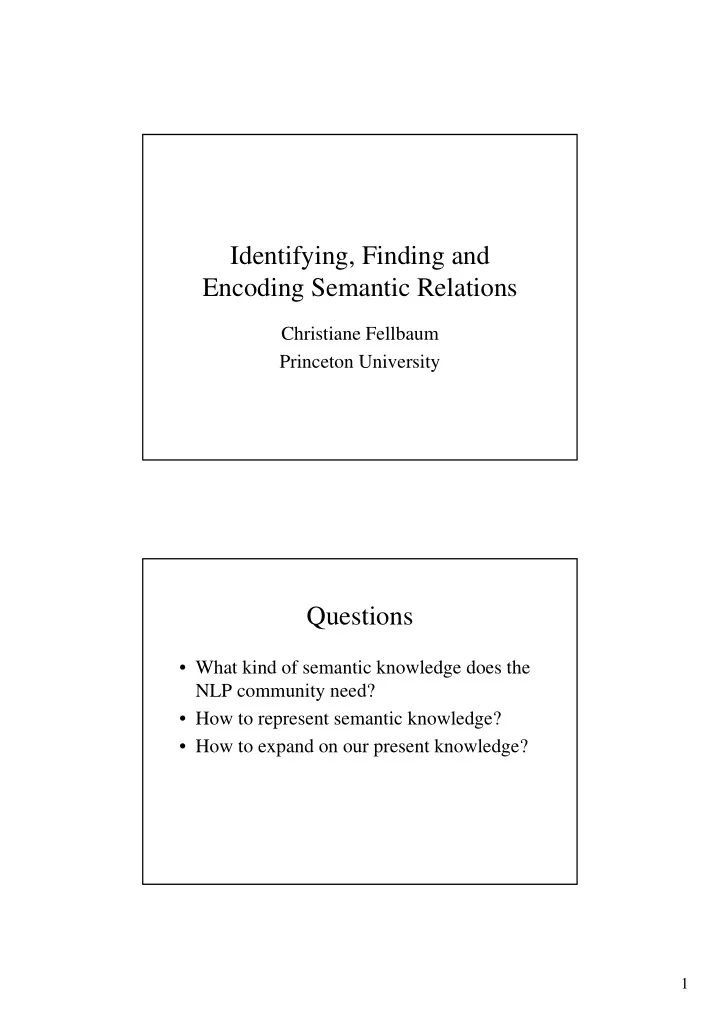

Identifying, Finding and Encoding Semantic Relations Christiane Fellbaum Princeton University Questions • What kind of semantic knowledge does the NLP community need? • How to represent semantic knowledge? • How to expand on our present knowledge? 1
Assumptions Need a repository for word form-meaning pairs (lexicon) that serves as a standard for word sense representation, applications and evaluation Assumptions • Lexicon has a structure • Entities, events, properties are labeled (more or less) systematically • Structure and lexicalization patterns can be captured with semantic and lexical relations • Relations reflect (dis)similarities among labeled concepts in a fairly systematic way • Semantic similarity as reflected by relations is useful for WSD 2
WordNet--the Plus side • Broad coverage • Multilingual • Freely accessible • Continually enriched both by Princeton and the user community Limitations of WordNet • Too sparse: too few relations, too few links • Few syntagmatic (cross-POS) links • Links are not weighted • Many arcs are not directed ( dollar->green , ? green->dollar ) • Sense inventory is too fine-grained for current automatic WSD • Polysemy would be less of a problem if WordNet’s internal connectivity was greater 3
Sources of WordNet-style relations • Classical relations (Aristotle) • Lexical-semantic analysis of entities, events (causation, entailment, troponymy,...) • Finding examples via lexico-syntactic patterns (Cruse 1986; Hearst 1993) • Lexico-syntactic patterns presuppose specific relations WordNet connections based on human judgment • (Robust) word association norms • Human judgments of associations among WordNet concepts show many connections not currently encoded (WordNetPlus, Boyd- Graber et al. 2006) • Can’t all be easily classified or labeled! 4
Moving away from preconceived relations • Reconsider: structure of the lexicon • Which concepts are distinguished and labeled with words? • Discover systematic differences among concepts/words that can be encoded as relations Focus: Rigidity • Important meta-property for distinguishing concepts in ontology • Rigidity distinguishes Types vs. Roles e.g., DOLCE ontology (Guarino and Welty 2002), Generative Lexicon (Pustejovsky 1995) 5
Rigidity rigid entities: dog, orchid, man, shirts ,.. vs. non-rigid : pet, houseplant, teacher, laundry ,... Adjectives stage-level vs. individual-level (Carlson 1977) tall, intelligent, female ,... vs. married, tired, surprised , ... time-dependent: John is no longer tired/married/*tall/*intelligent 6
Rigid and non-rigid terms may be related via shared hypernym plant orchid violet *houseplant Rigid and non-rigid terms are compatible and not mutually exclusive: This is an orchid and a houseplant (type, role co-hyponyms) cf. * This is an orchid and a violet (type co-hyponyms) 7
Non-rigid properties are defeasible: This orchid is not a houseplant (type) *This orchid is not a plant (role) Type and role nouns noun are semantically similar when sharing a superordinate A given entity can be labeled with both kinds of nouns Useful for co-reference resolution Temporal relations 8
Encoding Role and type nouns can be systematically distinguished and encoded linked to shared superordinates with para(llel) relations (Cruse 1986): plant orchid houseplant Relations in the verb lexicon Lexicalization patterns show systematic, productive encoding of hyponymy (troponymy), causation Verb classes: Manner verbs Change-of-state verbs Can be distinguished via syntactic criteria 9
Another relation Analogous to Type-Role distinction Distinguish hyponyms (troponyms) from “purpose” verbs examples: exercise, control, greet, help, punish don’t encode manner or change-of state not productive (?) “purpose” verbs move exercise run running is necessarily a kind of moving (hyponym) running is not necessarily a kind of exercising 10
Co-Hyponyms defeasible/non-defeasible Run but not {exercise/*move} Wave but not {greet/*gesture} Scrub but not {clean/*rub} the table Fair amount of verb hyponyms in WN are defeasible But no systematic encoding, distinction Relation is not always captured by co-hyponymy • Find verbs expressing purpose • encode them in WordNet with “parallel” relation, following Cruse’s suggestion for Types and Role • Problem: such concepts are not systematically encoded 11
Finding examples via lexico- syntactic patterns V-ing is (not) V-ing to V is (not) to V V-ing is a way of V-ing Patterns are also valid for regular hyponyms but few such pairs are extracted (for pragmatic reasons?) Web examples spraying the action with a little WD-40 is not cleaning shake hands , using the right hand, and explain that his is a way of greeting one another tipping, leaving a gratuity, is a way of thanking people for their service 12
Boyd-Graber, J., Fellbaum, C., Osherson, D. and Schapire, R. (2006). Adding dense, weighted connections to WordNet. Proceedings of the 3rd Global WordNet Association, Jeju, Korea. Carlson, G. (1977). Reference to Kinds in English . University of Massachusetts, Amherst Dissertation. Cruse, Alan (1986). Lexical Semantics . Cambridge: Cambride University Press. Fellbaum, Christiane (Ed., 1998). WordNet . Cambridge, MA: MIT Press. Fellbaum, Christiane (2002a). Parallel hierachies in the verb lexicon. in: K. Simov, (Ed.), Proceedings of the Ontolex02 Workshop, LREC, Las Palmas, Spain. . Fellbaum, Christiane (2002b). On the semantics of troponymy. In: Green, R. et al. (Eds.) Relations. Dordrecht: Kluwer. Fellbaum, C. (2003). Distinguishing Verb Types in a Lexical Ontology. Proceedings of the Conference on the Generative Lexicon, Geneva, Switzerland Guarino, N. and Welty, C. (2002), Evaluating Ontological Decisions with OntoClean . Communications of the ACM 45:2, 61-65. Hearst, M. (1992). Automatic acquisition of hyponyms from large text corpora . COLING 92, 539-545. Pustejovsky, J. (1995). The Generative Lexicon . Cambridge, MA: MIT Press. 13
Recommend
More recommend